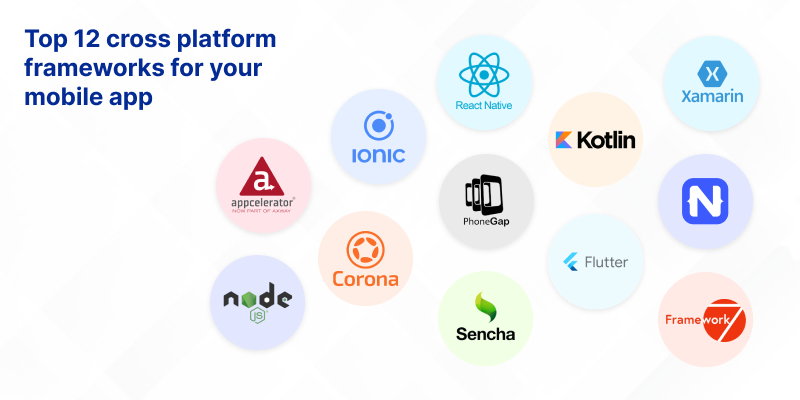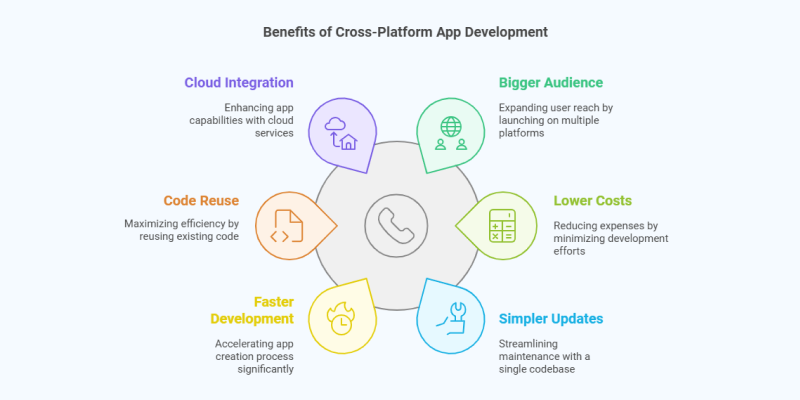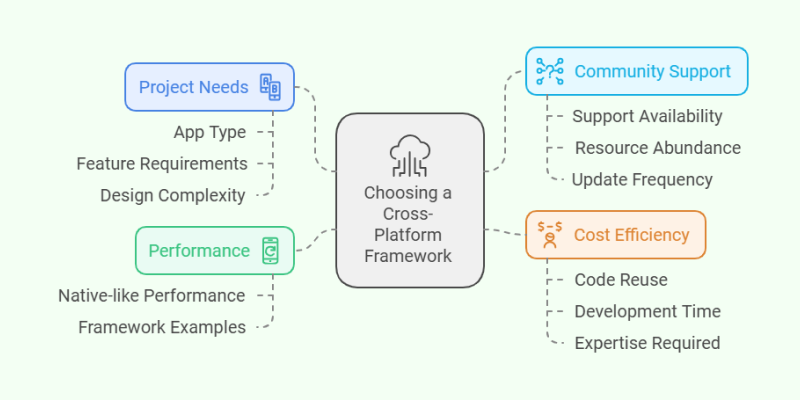Top 12 cross platform frameworks for your mobile app
Cross-platform app development has become increasingly popular due to its ability to efficiently create applications that run on multiple platforms with a single codebase. This has led to the emergence of a wide array of tools and frameworks that developers can leverage to streamline their development process. However, with so many options available, choosing the best framework can be a daunting task.
To help you find the most suitable framework for your mobile app, we’ve compiled a list of the top 10 cross-platform frameworks that are currently dominating the market. These frameworks, such as Node.js, React Native, Flutter, and PhoneGap, among others, offer outstanding performance, flexibility, and ease of use for developing high-quality mobile apps.
Before we dive into the details, it's important to note that most of these frameworks are built on JavaScript, so a solid understanding of JavaScript is essential for maximizing their potential. If you're new to the language, consider taking free online courses to strengthen your skills.
But first, let’s take a moment to define what cross-platform app development is all about.

What Is a Cross-Platform App Development Framework?
In simple terms, a cross-platform app development framework allows developers to build applications that run on multiple operating systems (iOS, Android, Windows, etc.) without needing to write separate code for each platform. The framework provides a unified codebase that works efficiently across different platforms, saving time and resources. Cross-platform development is one of the most popular approaches today, with most mobile app development companies utilizing it to deliver consistent, cost-effective solutions.
Best Frameworks for Developing Cross-Platform Mobile Apps
Ionic
Ionic is a powerful and widely-used framework based on AngularJS that enables developers to build mobile apps using HTML5, CSS, JavaScript, and Cordova plugins. It provides a rich set of UI components and tools, making it an excellent choice for Progressive Web App (PWA) development.
Features:
- Open-source and customizable, offering a flexible code structure.
- Built on AngularJS, which extends HTML's syntax with useful features and components.
- Uses Cordova plugins for accessing native device features like camera, GPS, and audio recording.
- Ideal for building native-like apps with excellent UI and interactivity.
React Native
React Native is a JavaScript-based framework that allows developers to build apps for both Android and iOS using a single codebase. It delivers a native-like experience while leveraging the power of JavaScript and React.js.
Features:
- Open-source and supported by a large community, ensuring continuous updates and bug fixes.
- Allows developers to write modules in native languages like Objective-C, Swift, or Java for heavy operations.
- Supports third-party plugins like Google Maps and has excellent UI rendering capabilities.
- One-time coding reduces app development time and cost, a significant advantage over other frameworks.
Flutter
Developed by Google, Flutter is a UI toolkit that facilitates the creation of natively compiled applications for mobile, web, and desktop from a single codebase. Known for its fast development process and highly dynamic user interfaces, it’s a top choice for developers.
Features:
- Uses a portable GPU for rendering, offering high-quality UI performance.
- Provides a reactive framework, so developers only need to update variables to trigger UI changes.
- Ideal for creating Minimum Viable Products (MVPs) quickly and cost-effectively.
- Built-in graphics engine for seamless app interfaces across platforms.
Xamarin
Xamarin allows developers to create native apps for Android, iOS, and Windows using C# and .NET. It enables code sharing across multiple platforms, reducing time and effort during development.
Features:
- Native-level app functionality with support for APIs and hardware features.
- Reduces hardware compatibility issues with powerful APIs and plugins.
- Offers native user interface elements and controls for high-quality app design.
- WORA (Write Once, Run Anywhere) functionality for cross-platform app development.
NativeScript
NativeScript is another powerful JavaScript-based framework that provides full access to native device APIs. Developers can reuse existing plugins and create apps with a truly native look and feel.
Features:
- Provides native UI components without relying on WebViews, ensuring better performance.
- Supports both Android and iOS APIs, allowing deep integration with native functionalities.
- Built using Angular and TypeScript, providing a rich development experience.
- Offers extensive plugin support from NPM for added functionality.
Node.js
Node.js is an open-source JavaScript runtime that is perfect for developing server-side applications. It's highly efficient, scalable, and can be used for building mobile backends that support cross-platform apps.
Features:
- Asynchronous and non-blocking I/O operations that ensure smooth performance.
- Efficient code execution due to its use of the Chrome V8 engine.
- Excellent for handling multiple concurrent connections.
- Rich library of modules for simplifying web and app development.
Appcelerator Titanium
Appcelerator Titanium offers a platform for developing cross-platform mobile apps with native components, all from a single codebase. It is known for its efficiency and integration capabilities.
Features:
- Rapid app development with the ability to create prototypes quickly.
- Includes ArrowDB for schema-less data storage.
- Supports integration with continuous delivery systems and external services like MS Azure and Salesforce.
PhoneGap
PhoneGap (also known as Apache Cordova) is a framework that uses web technologies like HTML, CSS, and JavaScript to develop cross-platform apps. It allows developers to access native device features, making it highly versatile.
Features:
- Uses web technologies for app development, which simplifies the learning curve.
- Access to native device APIs through plugins for functionality like GPS, camera, and storage.
- Ideal for building apps that need to run on multiple platforms without writing separate code.
Sencha Touch
Sencha Touch is a framework for building web-based cross-platform apps that are optimized for mobile devices. It’s ideal for developers who need to create high-performance apps with robust UI components.
Features:
- Built-in themes for all major platforms, including iOS, Android, and BlackBerry.
- Rich UI components like lists, forms, and carousels for mobile platforms.
- Supports Cordova integration for native API access and app packaging.
Corona SDK
Corona SDK is a framework specifically designed for creating 2D mobile apps and games. It is known for its fast development cycle and support for multiple platforms, including Kindle and Windows.
Features:
- Speed and efficiency in developing mobile and game apps, making it ideal for quick turnarounds.
- Lightweight Lua programming language for easy development and maintenance.
- Free framework that supports real-time testing.
Kotlin Multiplatform
Kotlin Multiplatform, created by JetBrains, allows developers to write shared code that works on both Android and iOS. It was introduced in 2017 and has become popular because it lets developers share the business logic while still customizing the app’s appearance for each platform.
Features:
- Share business logic across platforms, reducing code duplication and ensuring consistency.
- Use native UI components for both Android and iOS to maintain the platform’s look and feel.
- Easily integrates with existing Android and iOS projects, so you can adopt Kotlin gradually without rewriting your whole app.
Framework7
Framework7 is a free and open-source framework for building mobile, desktop, and web apps with a native look. It’s especially great for creating iOS and Android apps with a single codebase.
Features:
- Offers many UI elements like lists, forms, and cards to help create attractive and functional apps.
- Uses familiar web technologies like HTML, CSS, and JavaScript, making it easy for web developers to build mobile apps.
- Doesn’t require React or Angular but can work with them if needed, giving you more control over your app’s performance and behavior.
Comparison of Cross-Platform Mobile App Development Frameworks
This comparison of mobile app development frameworks will help you choose the best one for your project by outlining their pros, cons, and real-world uses.
Key Benefits of Cross-Platform App Development

Reach a Bigger Audience Build your app once and launch it on both iOS and Android, increasing your reach to more users.
Lower Development Costs By writing one codebase for multiple platforms, you can save money on development and maintenance.
Simpler Updates and Fixes With only one codebase to maintain, you can quickly update and fix bugs across all platforms at once.
Faster App Development Developing for multiple platforms using a single codebase can reduce development time by up to 80%, speeding up the process.
Reuse Your Code Code written once can be reused on different platforms, saving developers time and resources.
Easier Cloud Integration Cross-platform apps easily connect with cloud services to scale and add features without complex coding.
How to Pick the Right Cross-Platform Framework

Here are some important factors to consider when choosing the best framework for your app:
Understand Your Project Needs Know what kind of app you want to build, the features you need, and how complex your design is. For apps requiring complex animations, some frameworks perform better than others.
Consider Performance If your app needs to be highly responsive and feel like a native app, choose frameworks that offer close-to-native performance like Flutter or React Native.
Check the Community Support A strong community ensures better support, more resources, and easier troubleshooting. Bigger communities are also more likely to offer frequent updates and plugins.
Think About Cost Efficiency Some frameworks save you money by allowing code reuse across platforms, while others may require more time and expertise, increasing costs.
Final Thoughts
As new frameworks continue to emerge, it’s important to watch how existing ones perform in the competitive market. By choosing the right framework, you can create an app that works well on both iOS and Android, providing a smooth and consistent experience.
If you need a trusted mobile app development partner, Code-B offers expert cross-platform development services to help your business build high-quality apps.
Frequently Asked Questions (FAQs)
Cross-platform development saves time and money because you write one codebase for multiple platforms, like Android and iOS. While native development may offer slightly better performance, cross-platform frameworks can achieve similar results with less effort, making it a practical choice for most apps.
Some of the most widely used cross-platform frameworks include:
In many cases, cross-platform apps are fast enough for most users. Frameworks like Flutter and React Native are optimized for performance and can deliver near-native speed. However, for highly complex apps like 3D games or apps with heavy hardware requirements, native development might be slightly better.
It’s simple! Choose one of the many cross-platform frameworks available, such as React Native, Flutter, or Ionic. These tools help you build apps that look and work great on multiple platforms without needing to create separate versions for each one.
Cross-platform development is ideal for most apps, especially those that need to run on multiple platforms. However, if your app relies heavily on complex animations, cutting-edge hardware features, or platform-specific functionality, native development may be a better fit.
